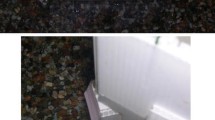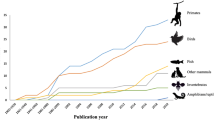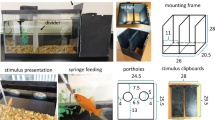Abstract
The tendency of fish to perceive the Ebbinghaus illusion was investigated. Redtail splitfins (Xenotoca eiseni, family Goodeidae) were trained to discriminate between two disks of different sizes. Then, fish were presented with two disks of the same size surrounded by disks of large or small size (inducers) arranged to produce the impression (to a human observer) of two disks of different sizes (in the Ebbinghaus illusion, a central disk surrounded by small inducers appears bigger than an identical one surrounded by large inducers). Fish chose the stimulus that, on the basis of a perception of the Ebbinghaus illusion, appeared deceptively larger or smaller, consistent with the condition of training. These results demonstrate that redtail splitfins tend to perceive this particular illusion. The results are discussed with reference to other related illusions that have been recently observed to be experienced by fish (such as the Navon effect), and with regard to their possible evolutionary implications.





Similar content being viewed by others
References
Aglioti S, DeSouza JF, Goodale MA (1995) Size-contrast illusions deceive the eye but not the hand. Curr Biol 5:679–685
Agrillo C, Miletto Petrazzini ME, Dadda M (2014) Illusory patterns are fishy for fish, too. Front Neural Circuits 7:137
Barbet I, Fagot J (2002) Perception of the corridor illusion by baboons (Papio papio). Behav Brain Res 132:111–115
Bayne K, Davis R (1983) Susceptibility of rhesus monkeys (Macaca mulatta) to the Ponzo illusion. Bull Psychon Soc 21:476–478
Cavoto KK, Cook RG (2001) Cognitive precedence for local information in hierarchical stimulus processing by pigeons. J Exp Psychol Anim Behav Proc 27(1):3–16
Cerella J (1980) The pigeon’s analysis of pictures. Pattern Recognit 12(1):1–6
Chiandetti C, Pecchia T, Patt F, Vallortigara G (2014) Visual hierarchical processing and lateralization of cognitive functions through domestic chicks’ eyes. PLoS One 9(1):e84435
Choplin JM, Medin DL (1999) Similarity of the perimeters in the Ebbinghaus illusion. Percept Psychophys 61:3–12
Cook RG (1992) Dimensional organization and texture discrimination in pigeons. J Exp Psychol Anim Behav Proc 18:354–363
Cook RG, Cavoto KK, Cavoto BR (1996) Mechanisms of multidimensional grouping, fusion, and search. Anim Learn Behav 24:150–167
Coren S, Enns JT (1993) Size contrast as a function of conceptual similarity between test and inducers. Percept Psychophys 54:579–588
Danckert JA, Sharif N, Haffenden AM, Schiff KC, Goodale MA (2002) A temporal analysis of grasping in the Ebbinghaus illusion: planning versus online control. Exp Brain Res 144:275–280
Darmaillacq AS, Dickel L, Rahmani N, Shashar N (2011) Do reef fish, Variola louti and Scarus niger, perform amodal completion? Evidence from a field study. J Comp Psychol 125:273
De Fockert J, Davidoff J, Fagot J, Parron C, Goldstein J (2007) More accurate size contrast judgments in the Ebbinghaus illusion by a remote culture. J Exp Psychol Hum Percept Perform 3:738–742
De Grave DDJ, Biegstraaten M, Smeets JBJ, Brenner E (2005) Effects of the Ebbinghaus figure on grasping are not only due to misjudged size. Exp Brain Res 163:58–64
Deruelle C, Fagot J (1998) Visual search for global/local stimulus features in humans and baboons. Psychon Bull Rev 5:476–481
Ebbinghaus H (1902) Grundzüge der psychologie. Veit, Leipzig
Fagot J, Deruelle C (1997) Processing of global and local visual information and hemispheric specialization in humans (Homo sapiens) and baboons (Papio papio). J Exp Psychol Hum Percept Perform 23:429–442
Forkman B, Vallortigara G (1999) Minimization of modal contours: an essential cross species strategy in disambiguating relative depth. Anim Cogn 4:181–185
Fremouw T, Herbranson WT, Shimp CP (1998) Priming of attention to local and global levels of visual analysis. J Exp Psychol Anim Behav Proc 24:278–290
Fremouw T, Herbranson WT, Shimp CP (2002) Dynamic shifts of pigeon local/global attention. Anim Cogn 5:233–243
Fujita K (1996) Linear perspective and the Ponzo illusion: a comparison between rhesus monkeys and humans. Jpn Psychol Res 38:136–145
Fujita K (1997) Perception of the Ponzo illusion by rhesus monkeys, chimpanzees, and humans: similarity and difference in the three primate species. Percept Psychophys 59:284–292
Fujita K, Blough DS, Blough PM (1991) Pigeons see the Ponzo illusion. Anim Learn Behav 19:283–293
Fujita K, Blough DS, Blough PM (1993) Effects of the inclination of context lines on perception of the Ponzo illusion by pigeons. Anim Learn Behav 21:29–34
Fuss T, Bleckmann H, Schluessel V (2014) The brain creates illusions not just for us: sharks (Chiloscyllium griseum) can “see the magic” as well. Front Neural Circuits 20:8–24
Geiger G, Poggio T (1975) The Müller-Lyer figure and the fly. Science 190:479–480
Girgus JS, Coren S, Agdern M (1972) The interrelationship between the Ebbinghaus and Delboeuf illusions. J Exp Psychol 95:453–455
Goodale MA, Milner AD (1992) Separate visual pathways for perception and action. Trends Neurosci 15:20–25
Happé F (1996) Studying weak central coherence at low levels: children with autism do not succumb to visual illusions. A research note. J Child Psychol Psychiatry 37:873–877
Horridge GA, Zang S-W, O’Carrol D (1992) Insect perception of illusory contours. Philos Trans R Soc Lond B 337:59–64
Kaldy Z, Kovacs I (2003) Visual context integration is not fully developed in 4-year-old children. Perception 32:657–666
Kimchi R (1992) Primacy of wholistic processing and global/local paradigm: a critical review. Psychol Bull 112:24–38
Kinchla RA, Wolf JM (1979) The order of visual processing: top-down, bottom-up, or middle-out. Percept Psychophys 25:225–231
Kinchla RA, Solis-Macias V, Hoffman J (1983) Attending to different levels of structure in a visual image. Percept Psychophys 33:1–10
Kumar S, Hedges SB (1998) A molecular timescale for vertebrate evolution. Nature 392:917–920
Mascalzoni E, Regolin L (2011) Animal visual perception. Wiley Interdiscip Rev Cogn Sci 2:106–116
Massaro DW, Anderson NH (1971) Judgemental model of the Ebbinghaus illusion. J Exp Psychol 89:147–151
Murayama T, Usui A, Takeda E, Kato K, Maejima K (2012) Relative size discrimination and perception of the Ebbinghaus illusion in a bottlenose dolphin (Tursiops truncatus). Aquat Mamm 38:333–342
Nakamura N, Fujita K, Ushitani T, Miyata H (2006) Perception of the standard and the reversed Müller-Lyer figures in pigeons (Columba livia) and humans (Homo sapiens). J Comp Psychol 120:252–261
Nakamura N, Watanabe S, Fujita K (2008) Pigeons perceive the Ebbinghaus–Titchener circles as an assimilation illusion. J Exp Psychol Anim Behav Proc 34(3):375–387
Nakamura N, Watanabe S, Fujita K (2009) Further analysis of perception of reversed Müller-Lyer figures for pigeons (Columba livia). Percept Mot Skills 108:239–250
Nakamura N, Watanabe S, Fujita K (2014) A reversed Ebbinghaus–Titchener illusion in bantams (Gallus gallus domesticus). Anim Cogn 17:471–481
Navon D (1977) Forest before trees: precedence of global features in visual perception. Cogn Psychol 9:353–383
Oyama T (1960) Japanese studies on the so-called geometrical-optical illusions. Psychologia 3:7–20
Parron C, Fagot J (2007) Comparison of grouping abilities in humans (Homo sapiens) and baboons (Papio papio) with Ebbinghaus illusion. J Comp Psychol 121:405–411
Pepperberg IM, Vicinay J, Cavanagh P (2008) Processing of the Müller-Lyer illusion by a grey parrot (Psittacus erithacus). Perception 37:765–781
Phillips WA, Chapman KL, Berry PD (2004) Size perception is less context sensitive in males. Perception 33:79–86
Pomerantz JR (1983) Global and local precedence: selective attention in form and motion perception. J Exp Psychol Gen 112:516–540
Regolin L, Vallortigara G (1995) Perception of partly occluded objects by young chicks. Percept Psychophys 57:971–976
Regolin L, Marconato F, Vallortigara G (2004) Hemispheric differences in the recognition of partly occluded objects by newly-hatched domestic chicks (Gallus gallus). Anim Cogn 7:162–170
Reiner A, Yamamoto K, Karten HJ (2005) Organization and evolution of the avian forebrain. Anat Rec A Discov Mol Cell Evol Biol 287A:1080–1120
Roberts B, Harris MG, Yates TA (2005) The roles of inducer size and distance in the Ebbinghaus illusion (Titchener circle). Perception 34:847–856
Robertson LC, Egly R, Lamb MR, Kerth L (1993) Spatial attention and cuing to global and local levels of hierarchical structure. J Exp Psychol Hum Percept Perform 19:471–487
Rosa Salva O, Rugani R, Cavazzana A, Regolin L, Vallortigra G (2013) Perception of the Ebbinghaus illusion in four-day-old domestic chicks (Gallus gallus). Anim Cogn 16:895–906
Rosa Salva O, Sovrano VA, Vallortigara G (2014) What can fish brains tell us about visual perception. Front Neural Circuits 8:119. doi:10.3389/fncir.2014.00119
Shimizu T (2004) Comparative cognition and neuroscience: misconceptions about brain evolution. Jpn Psychol Res 46:246–254
Shimizu T, Bowers AN (1999) Visual circuits of the avian telencephalon: evolutionary implications. Behav Brain Res 98:183–191
Sovrano VA, Bisazza A (2008) Recognition of partly occluded objects by fish. Anim Cogn 11:161–166
Sovrano VA, Bisazza A (2009) Perception of subjective contours in fish. Perception 38:579–590
Steinke D, Salzburger W, Meyer A (2006) Novel relationships among ten fish model species revealed based on a phylogenomic analysis using ESTs. J Mol Evol 62:772–784
Suganuma E, Pessoa VF, Monge-Fuentes V, Castro BM, Tavares MCH (2007) Perception of the Müller-Lyer illusion in capuchin monkeys (Cebus apella). Behav Brain Res 182:67–72
Sutherland NS, Mackintosh NJ (1971) Mechanisms of animal discrimination learning. Academic Press, London
Timney B, Keil K (1996) Horses are sensitive to pictorial depth cues. Perception 25:1121–1128
Truppa V, Sovrano VA, Spinozzi G, Bisazza A (2010) Processing of visual hierarchical stimuli by fish (Xenoteca eiseni). Behav Brain Res 207(1):51–60
Tudusciuc O, Nieder A (2010) Comparison of length judgments and the Müller-Lyer illusion in monkeys and humans. Exp Brain Res 207:221–231
Ushitani T, Fujita K, Yamanaka R (2001) Do pigeons (Columba livia) perceive object unity? Anim Cogn 4:153–161
Vallortigara G (2004) Visual cognition and representation in birds and primates. In: Rogers LJ, Kaplan G (eds) Vertebrate comparative cognition: are primates superior to non-primates?. Kluwer Academic/Plenum Publishers, New York, pp 57–94
Vallortigara G (2006) The cognitive chicken: visual and spatial cognition in a non-mammalian brain. In: Wasserman EA, Zentall TR (eds) Comparative cognition: experimental explorations of animal intelligence. Oxford University Press, Oxford, pp 41–58
Vallortigara G (2009) Original knowledge and the two cultures. In: Carafoli E, Danieli GA, Longo GO (eds) The two cultures: shared problems. Springer, Berlin, pp 125–145
Vallortigara G (2012) Core knowledge of object, number, and geometry: a comparative and neural approach. Cogn Neuropsychol 29:213–236
Vallortigara G, Chiandetti C, Rugani R, Sovrano VA, Regolin L (2010) Animal cognition. Wiley Interdiscip Rev Cogn Sci 1:882–893
Wade NJ (2005) Perception and illusions, historical perspectives. Springer, Dordrecht
Wade NJ (2010) Visual illusions. Corsini encyclopedia of psychology. Wiley, Hoboken, pp 1–2
Warden CJ, Baar J (1929) The Müller-Lyer illusion in the ring dove, Turtur risorius. J Comp Psychol 9(4):275–292
Wasserman EA, Kirkpatrick-Steger K, Van Hamme LJ, Biederman I (1993) Pigeons are sensitive to the spatial organization of complex visual stimuli. Psychol Sci 4:336–341
Weintraub DJ (1979) Ebbinghaus illusion: context, contour, and age influence the judged size of a circle admist circles. J Exp Psychol Hum Percept Perform 5:353–364
Winslow CN (1933) Visual illusions in the chick. Arch Physiol 153:1–83
Wyzisk K (2005) Experimente zur Form- und Größenwahrnehmung beim Goldfisch (Carassius auratus) unter Verwendung von Scheinkonturen und Größentäuschungen. Ph.D. thesis, Johannes-Gutenberg-Universität Mainz, Germany
Wyzisk K, Neumeyer C (2007) Perception of illusory surfaces and contours in goldfish. Vis Neurosci 24:291–298
Yamazaki Y, Otsuka Y, Kanazawa S, Yamaguchi MK (2010) Perception of the Ebbinghaus illusion in 5-to-8-month-old infants. Jpn Psychol Res 52(1):33–40
Acknowledgments
This study was supported by research grant from the Cassa di Risparmio of Trento e Rovereto. We wish to thank Matteo Kettmaier for his help with the experiments and Francesco Cerri for the maintenance of the aquaria.
Conflict of interest
The authors declare that they have no conflict of interest.
Ethical standard
The experiments reported here comply with the current Italian and European Community laws for the ethical treatment of animals.
Author information
Authors and Affiliations
Corresponding author
Rights and permissions
About this article
Cite this article
Sovrano, V.A., Albertazzi, L. & Rosa Salva, O. The Ebbinghaus illusion in a fish (Xenotoca eiseni). Anim Cogn 18, 533–542 (2015). https://doi.org/10.1007/s10071-014-0821-5
Received:
Accepted:
Published:
Issue Date:
DOI: https://doi.org/10.1007/s10071-014-0821-5




